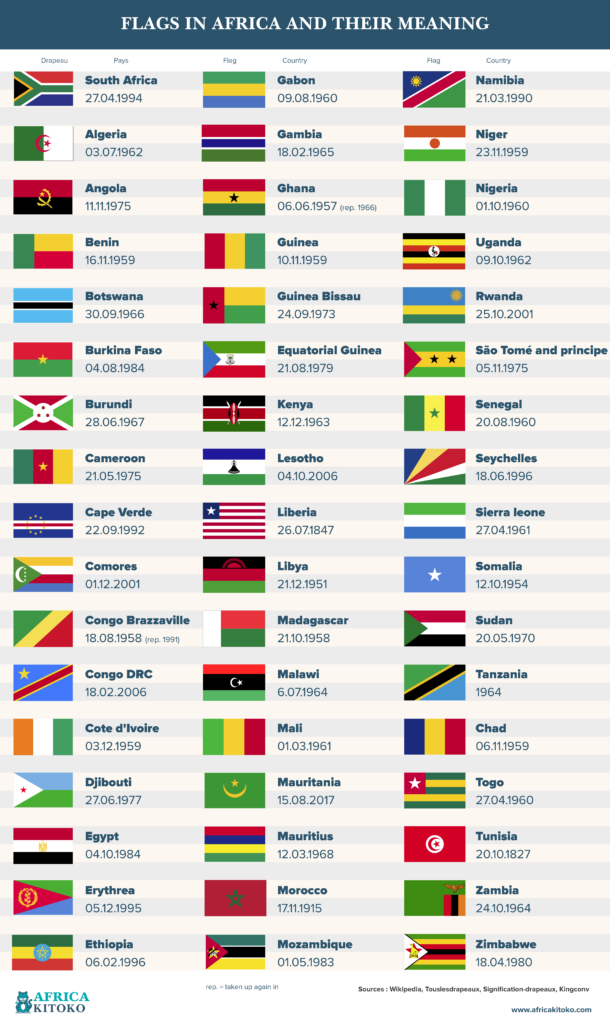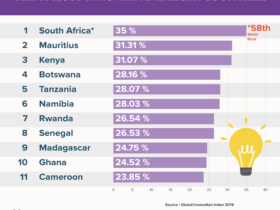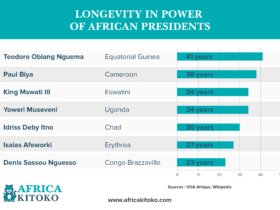
South Africa April 27, 1994
The black: the people who were in this territory before colonization
Yellow (gold): the resources of the subsoil (diamond and other)
The blue and the red: The colonizers: Afrikaner (Dutch) and English
White: symbols of democracy
Green: represents the path to peace. «
Algeria July 3, 1962
« Green represents prosperity and the land, but it is also the color of paradise in Islam.
White represents purity and peace.
The crescent represents the path that a Muslim must travel during his life to hope to reach Paradise
The 5-pointed star represents the five pillars of Islam «
Angola November 11, 1975 « The red represents the blood spilled during their war of independence
Black represents the African continent.
The cogwheel represents the workers
The machete the peasants and the star solidarity and progress
The crossed wheel and machete directly refer to the sickle and hammer of the Soviet flag. «
Benin 16 November 1959
« In the green you will read the hope of renewal
From your ancestors, red evokes courage
Of the richest treasures, yellow is the omen. «
Botswana September 30, 1966
« Blue symbolizes water, and more precisely rain which is the national currency
The black and white bands represent the harmony between the races, and also refer to the zebra,
animal symbol of the country, which is depicted on the country’s coat of arms. «
Burkina Faso August 4, 1984
« the light red band represents the desert plains in the north of the country
the yellow star represents the light guiding the people, but also Ouagadougou
the green band represents the agricultural and green lands in the south of the country «
Burundi June 28, 1967
« Green symbolizes: hope
White symbolizes: peace
Red symbolizes: love of the motherland
The three stars symbolize Unity – Work – Progress «
Cameroon May 21, 75
« Green for the forests of the south of the country
Red for the blood shed by the people
Yellow for the savannah in the north of the country.
The yellow star symbolizes the unity of the country. «
Cape Verde September 22, 1992
« Blue symbolizes the Atlantic Ocean
the ten stars symbolize the ten islands that make up the archipelago
The arrangement in a circle can recall both the geographical arrangement and the unity of the inhabitants.
The white stripe represents the pacifism of the Cape Verdeans and the red their hard work. «
Comoros December 1, 2001
« The four stars and the four bands symbolize the four islands of the archipelago
yellow for Mohéli (Mwali), blue for Grande Comore (Ngazidja)
the red for Anjouan (Nzuwani) and the white for Mayotte (Maoré), a French overseas department, but still claimed by the Comoros.
The green and the white crescent are traditional symbols of Islam,
dominant religion in the Comoros since Arab colonization «
Congo August 18, 1958 (then resumed in 1991)
« Red for the struggle for freedom
Green for the country’s nature
Yellow symbolizes the natural riches of nature. «
DRC 18 February 2006 « The color sky blue symbolizes peace
The red stripe represents the blood of the martyrs
The color yellow is the sign of the country’s wealth
the yellow star points to a united country with a bright future. «
Ivory Coast December 3, 1959 « The first, orange in color, symbolizes the savannas of the north of the country and fertility
The second band, white in color, represents peace
The third, green in color, symbolizes both hope and the forests of the south of the country. «
Djibouti June 27, 1977 «
It consists of two horizontal bands,
blue (symbolizing the sea and the sky) and green (representing the earth), and a white isosceles triangle (for peace) located on the side of the pole. In the middle of the triangle, a red five-pointed star symbolizes national unity. «
Egypt October 4, 1984
« The red refers to the time before the military coup that overthrew King Farouk in 1952.
This coup d’etat, carried out without shedding blood, is symbolized by the color white.
Black represents the end of the oppression of British settlers on the Egyptian people.
The Eagle of Saladin originates from the Egyptian vizier Saladin who unified the Arab world in the 12th century. «
Eritrea December 5, 1995
« The green triangle represents agriculture, the idea of fertile land.
Blue is reminiscent of the Red Sea.
Red represents the blood shed for the independence of Eritrea and for the homeland.
The golden olive branches symbolize the country’s mineral wealth. «
Ethiopia 6 February 1996
« Green represents the hope and fertility of the earth
Yellow symbolizes justice and harmony
Red represents sacrifice and heroism in the defense of the earth
The blue of the disc symbolizes peace and the pentagram represents the unity and equality of the nationalities and peoples of Ethiopia. «
Gabon August 9, 1960
« Green symbolizes the equatorial forest
Yellow the equator and blue the sea. «
Gambia February 18, 1965
« The red stripe symbolizes the sun
The blue stripe symbolizes the Gambia River
The green stripe symbolizes the forest and agriculture.
The 2 white borders symbolize the union of the country and peace. «
Ghana June 6, 1957 (then resumed in 1966)
« The red is reminiscent of the blood spilled by the people to gain their independence.
Yellow represents the wealth of the country and in particular the gold present in its subsoil
Green represents the country’s natural resources.
The black star reminds us that this country is the first African country to have gained its independence in 1957. «
Guinea November 10, 1959
« The color red symbolizes the blood shed by the people to gain their independence.
The yellow color symbolizes the mineral wealth of the subsoil, in particular gold, diamonds, bauxite and iron.
The green color symbolizes the forests in the south of the country and the savannah in the north. «
Guinea Bissau September 24, 1973
« The color red symbolizes the blood shed by the people to gain their independence.
The yellow color symbolizes the mineral wealth of the subsoil, in particular gold, diamonds, bauxite and iron.
The green color symbolizes vegetation and more symbolically hope and future life.
The black star recalls his emancipation from Portuguese rule. «
Equatorial Guinea August 21, 1979
« Green is reminiscent of vegetation, in particular tropical forests
White evokes peace and red the blood spilled for freedom
Blue evokes the Atlantic Ocean.
The 6 stars represent the 6 islands of the country. «
Kenya December 12, 1963
« The color black symbolizes the Kenyan people
The red color symbolizes the blood spilled by the people to conquer their independence
The green color symbolizes the vegetation and the wealth of the country.
The white borders symbolize peace.
The shield and crossed spears symbolize the defense of freedom. «
Lesotho October 4, 2006
« The blue color represents rain,
The white color represents peace,
The color green represents prosperity.
The black hat represents the unity of the country.
The black basuto hat, which represents the indigenous population. «
Liberia July 26, 1847
“The bands symbolize the signatories of Liberia’s declaration of independence.
The blue square represents the African continent and the star represents the freedom granted to former slaves «
Libya December 21, 1951
« Red represents the Fezzan
Black symbolizes Cyrenaica
Tripolitania is represented by green
The crescent and the star represent Islam, the main religion of the country. «
Madagascar October 21, 1958
« Red recalls sovereignty
The strength of the Malagasy state and patriotism
White reflects the purity of heart and the loyalty of the Malagasy
The green is reminiscent of agriculture and the many, sometimes unique, species of the country, and more symbolically hope. «
Malawi July 6, 1964
« The black represents the liberated African people
The color red symbolizes the blood shed by the people to conquer their freedom.
The sun was added to symbolize the advent of hope and freedom.
Green symbolizes vegetation. «
Mali March 1, 1961
« Green represents vegetation, meadows, fields, in the 2nd degree, it symbolizes hope.
The gold color represents the wealth of the country, in particular its gold mines.
The color red is both a tribute to all the bloodshed to defend the country and conquer its freedom. «
Mauritania August 15, 2017
« The crescent, the star and the color green are traditional symbols of Islam
The gold color represents the sands of the Sahara
The red color, added after a referendum in 2017, recalls the bloodshed for the homeland. «
Mauritius March 12, 1968
“The red is reminiscent of the blood spilled during colonization.
The blue evokes the Indian ocean and the sky
Yellow represents the sun but also unity.
The green evokes the lush vegetation of the island, forests and agriculture, one of the main resources of the island. «
Morocco November 17, 1915
« The red would represent the blood of the martyrs who fell during the conquest of the country
by the Ottomans, in 1574
White symbolizes peace
The crescent represents the unity of all Muslims and the branches of the star the five pillars of Islam «
Mozambique May 1, 1983
« The color green represents agricultural wealth
The black represents the people and the African continent
Red is the symbol of the people’s struggle to conquer and keep their independence
The white borders indicate that the country is peaceful.
The yellow star is a reference to the country’s socialist history
The book represents education, the hoe peasants and agriculture
The machine gun the determination of the people to defend their freedom. «
Namibia March 21, 1990
« Blue evokes the sky, the Pacific Ocean, but also rain and water resources.
Green represents vegetation and all agriculture.
Red symbolizes the heroism of the people and their fight for a better future.
The white borders symbolize peace and unity,
The yellow sun represents both the climate and the happiness of being free from bondage. «
Niger 23 November 1959
« The orange color also represents the dry regions of the north of the country, the Sahara.
The color green represents the more fertile regions of the south and west of the country, it also symbolizes hope.
White symbolizes purity and innocence. «
Nigeria October 1, 1960
« Green represents agriculture but also all vegetation
White symbolizes peace and unity.
The white band would be the Niger River crossing the forests of the south of the country. «
Uganda October 9, 1962
« The crane is the symbolic animal of the country
These colors also symbolize the African people for black,
The sun for yellow and the blood shed by the people for their freedom is red. «
Rwanda October 25, 2001
« The color blue symbolizes happiness and peace
The yellow color symbolizes the country’s wealth and economic development
The green is prosperity and hope.
The yellow sun symbolizes the light which illuminates the people and leads them towards unity and progress. «
Sao Tome and Principe November 5, 1975
« Red is the color of blood spilled during the struggle for independence
Yellow refers to cocoa trees which are the archipelago’s main resource
Tropical vegetation is found in the green.
The two stars represent the two islands that make up the country and the black one belongs to the African continent. «
Senegal August 20, 1960
« We also give the meaning to green Islam or more generally religions and hope
The yellow represents the wealth of the country and the red the bloodshed to defend the country and gain its independence.
The star does not have a revolutionary meaning but simply signifies the unity of countries. «
Seychelles June 18, 1996 «
The blue color represents the sky and the sea surrounding the Seychelles.
Yellow represents the sun which gives light and life,
Red symbolizes the people and their determination to work for the future in unity and love,
The color white symbolizes social justice and harmony.
Green represents the land and the natural environment. «
Sierra leone April 27, 1961
« Green represents agriculture, mountains and natural resources
Blue, the hope of peace that Freetown intends to bring to the rest of the world
White recalls unity and justice. «
Somalia October 12, 1954
« The light blue color is used in honor of the United Nations under the aegis of which the country obtained its independence.
The five branches of the star represent the five ethnic groups that make up the country:
– The Issas of Djibouti,
– Somalis in Ethiopia,
– The Issaks of Somaliland,
– Somalis in ancient Italian Somalia,
– Somalis in northern Kenya. «
Sudan May 20, 1970 « White, that of the Umayyads of Damascus
Black, that of the Abbasids of Baghdad
Green, that of the Fatimids
Red is often associated with the Hashemite house, descendants of Muhammad «
Tanzania 1964
« The colors black, green and blue come from the flag of Zanzibar
The black green colors and the yellow borders of that of Tanganyika
The green represents the vegetation of the country, the blue the lakes, the rivers and the Indian Ocean
The black symbolizes the African people and the yellow symbolizes the country’s mineral resources. «
Chad November 6, 1959 «
Blue represents the sky and especially the water, the main water point of the country being Lake Chad.
Yellow represents the sun and the sand,
Red symbolizes all the sacrifices made by the Chadian people to defend their country and conquer their freedom. «
Togo April 27, 1960
« The yellow represents the country’s mineral resources, the green represents the forest and agriculture, it also symbolizes hope,
Red symbolizes the blood spilled by the people to defend their country and conquer their freedom.
The white star symbolizes freedom, peace and the hope and independence of Togo. «
Tunisia October 20, 1827
« The red evokes the blood of the martyrs who fell during the conquest of the Ottomans, the white symbolizes peace.
The crescent represents the unity of all Muslims and the branches of the star the five pillars of Islam «
Zambia October 24, 1964
« The importance of green recalls the preponderance of agriculture in the country’s economy.
Red evokes struggles for independence
Black refers to African roots
The orange represents the country’s mineral resources, especially copper. «
Zimbabwe April 18, 1980
« The color black represents the black majority in the country,
Red represents the blood shed to conquer freedom and independence,
Yellow represents mineral wealth and green represents vegetation and agriculture.
The white triangle symbolizes peace, the red star is a reference to socialism and reflects the aspirations of the nation.
The yellow bird (Zimbabwe bird) is the emblem of the country. «









Leave a Reply
View Comments